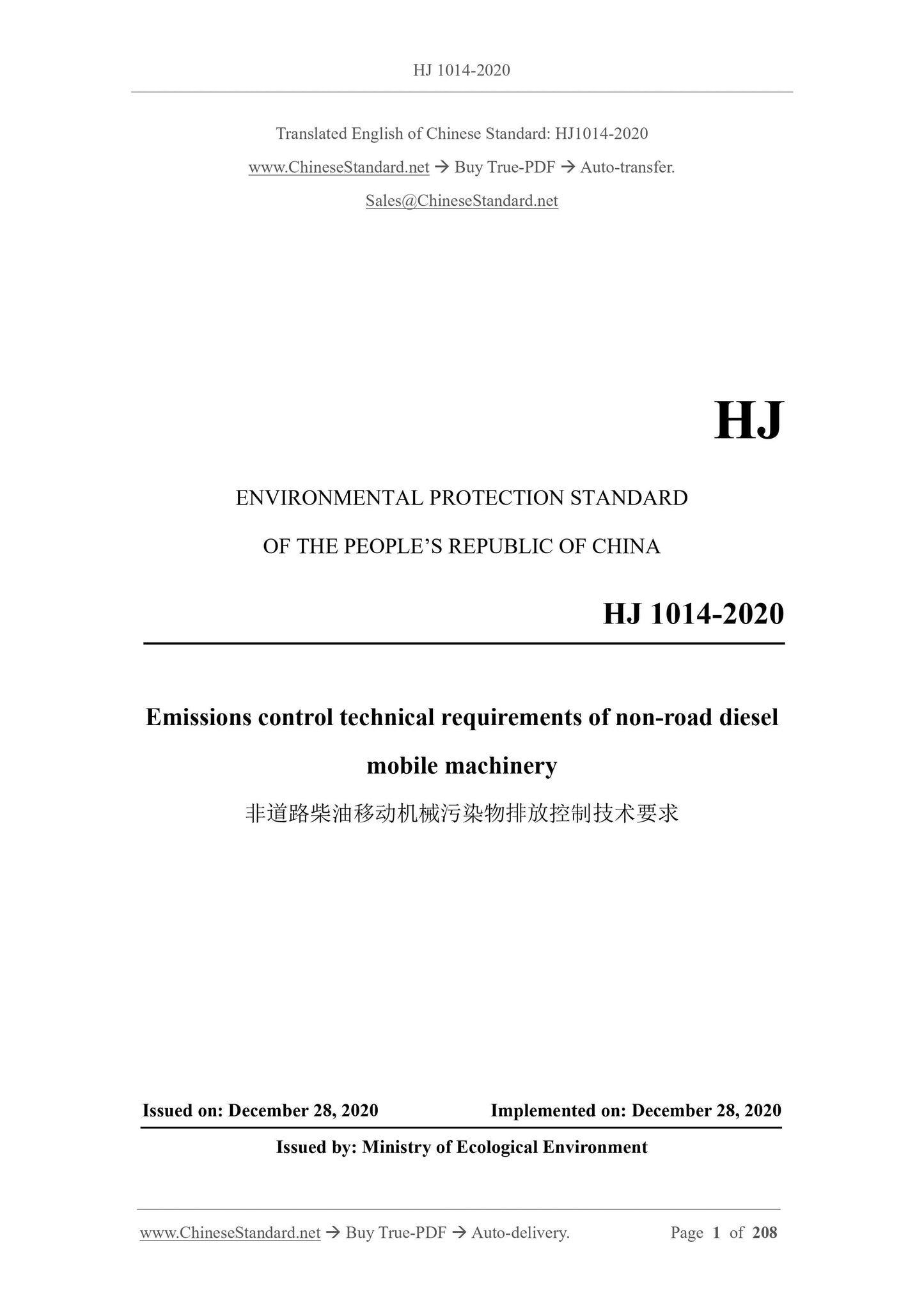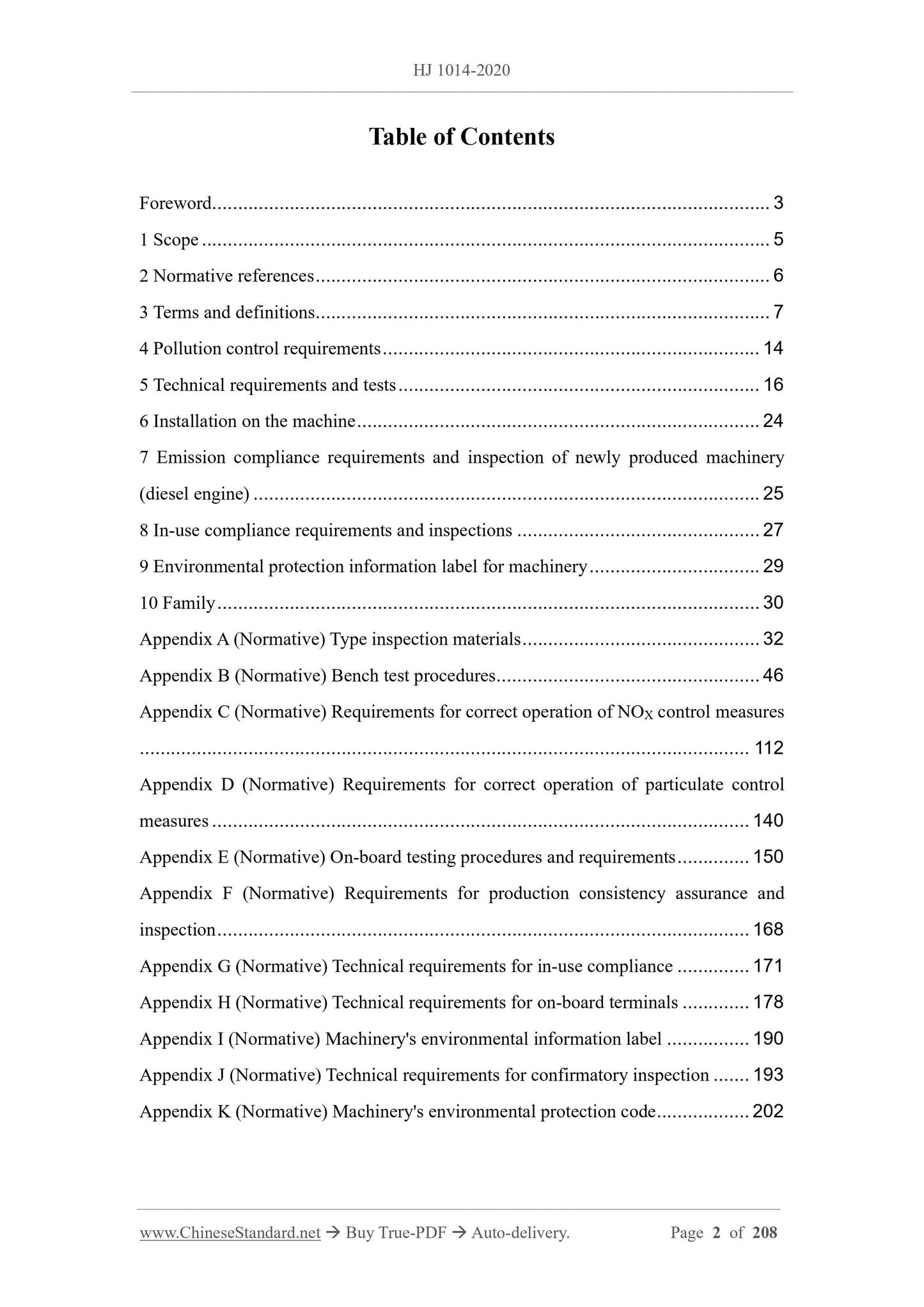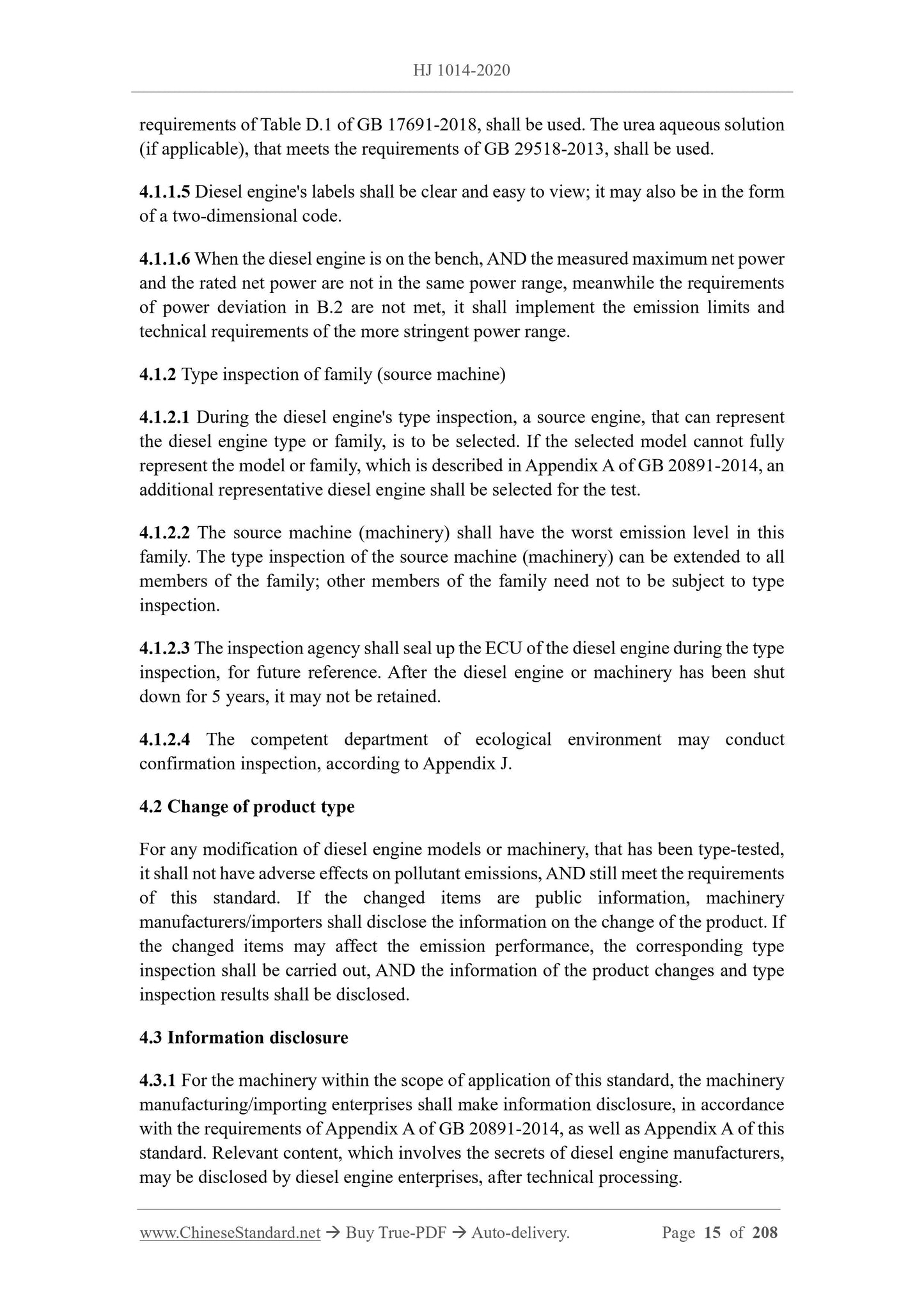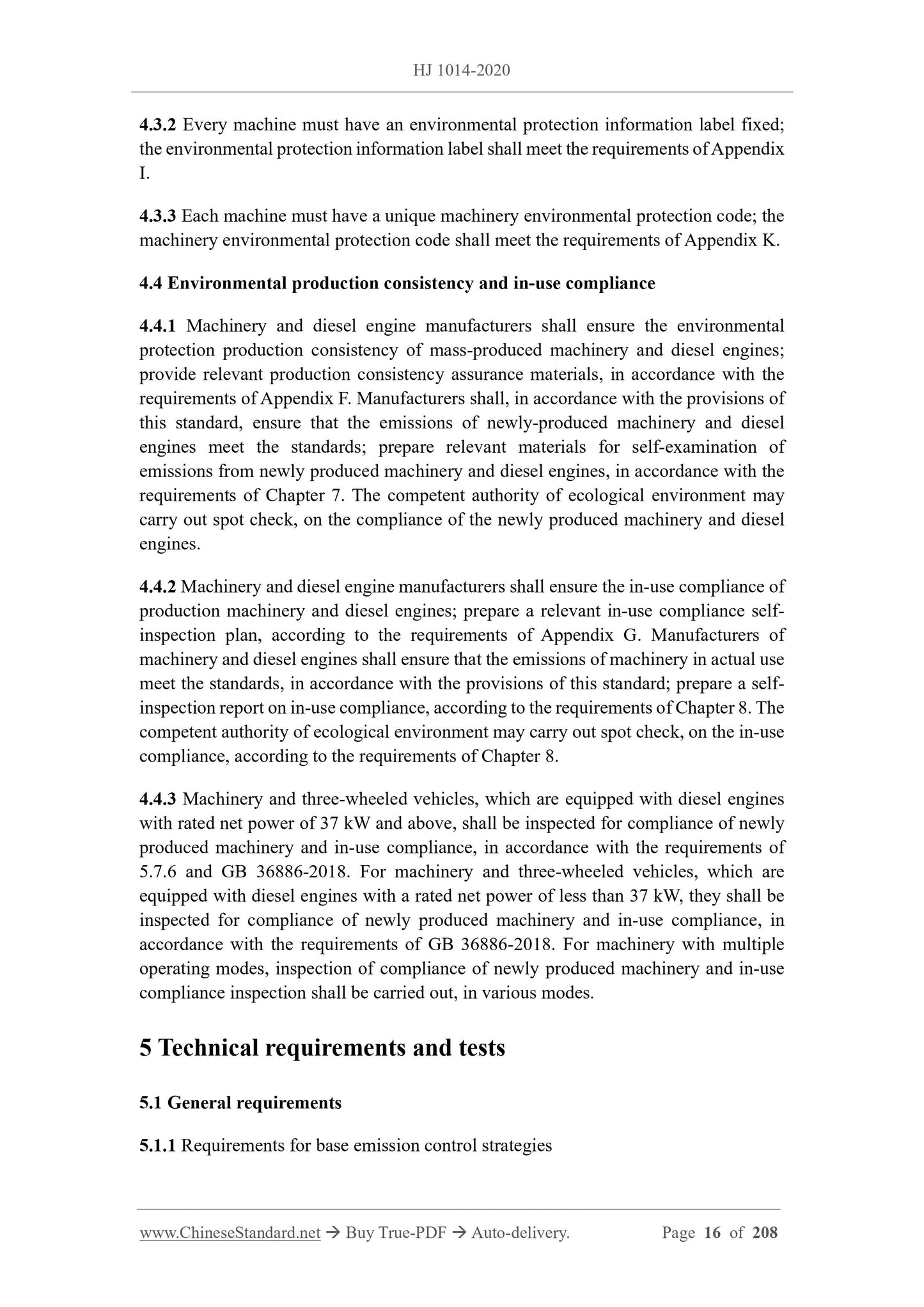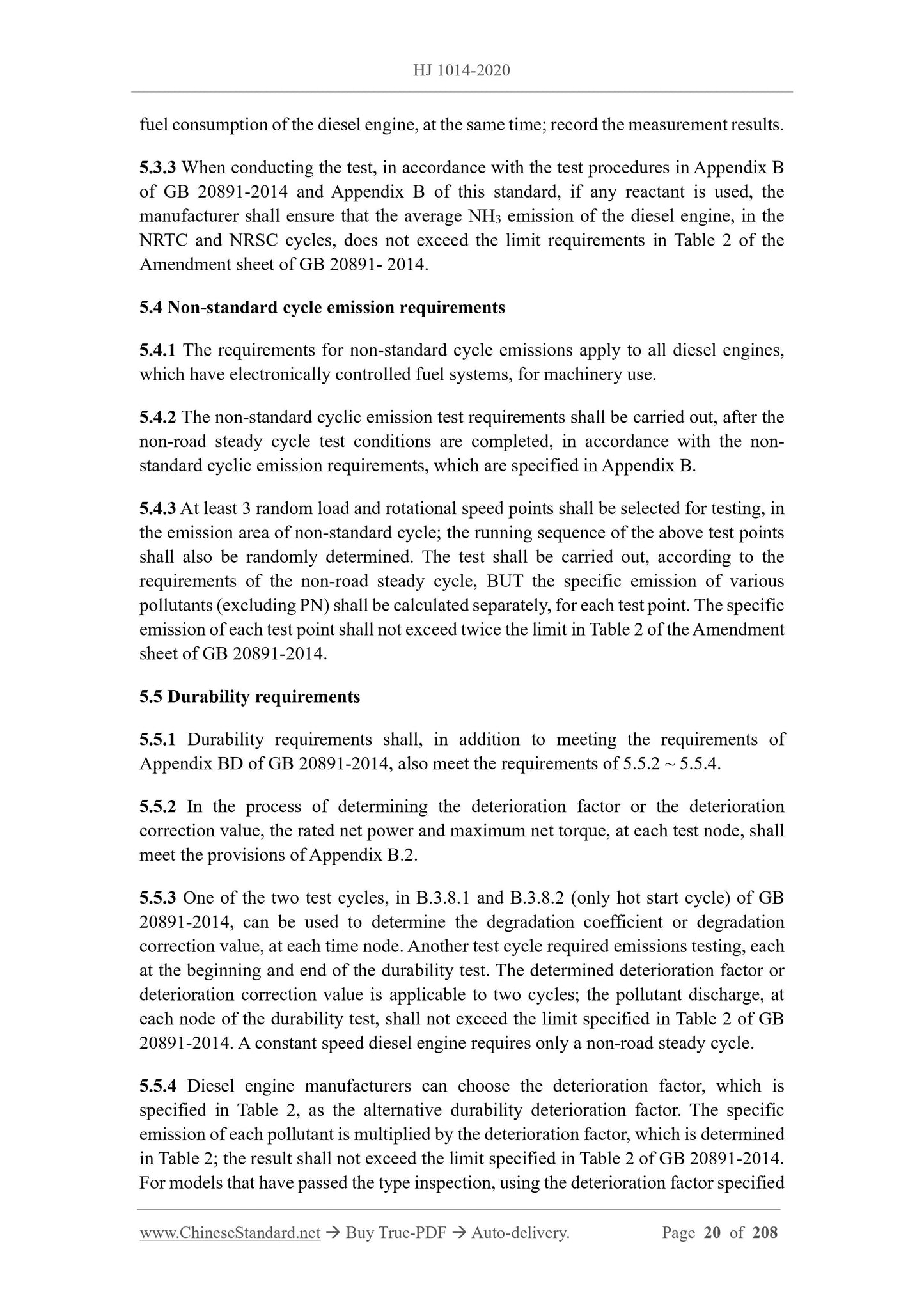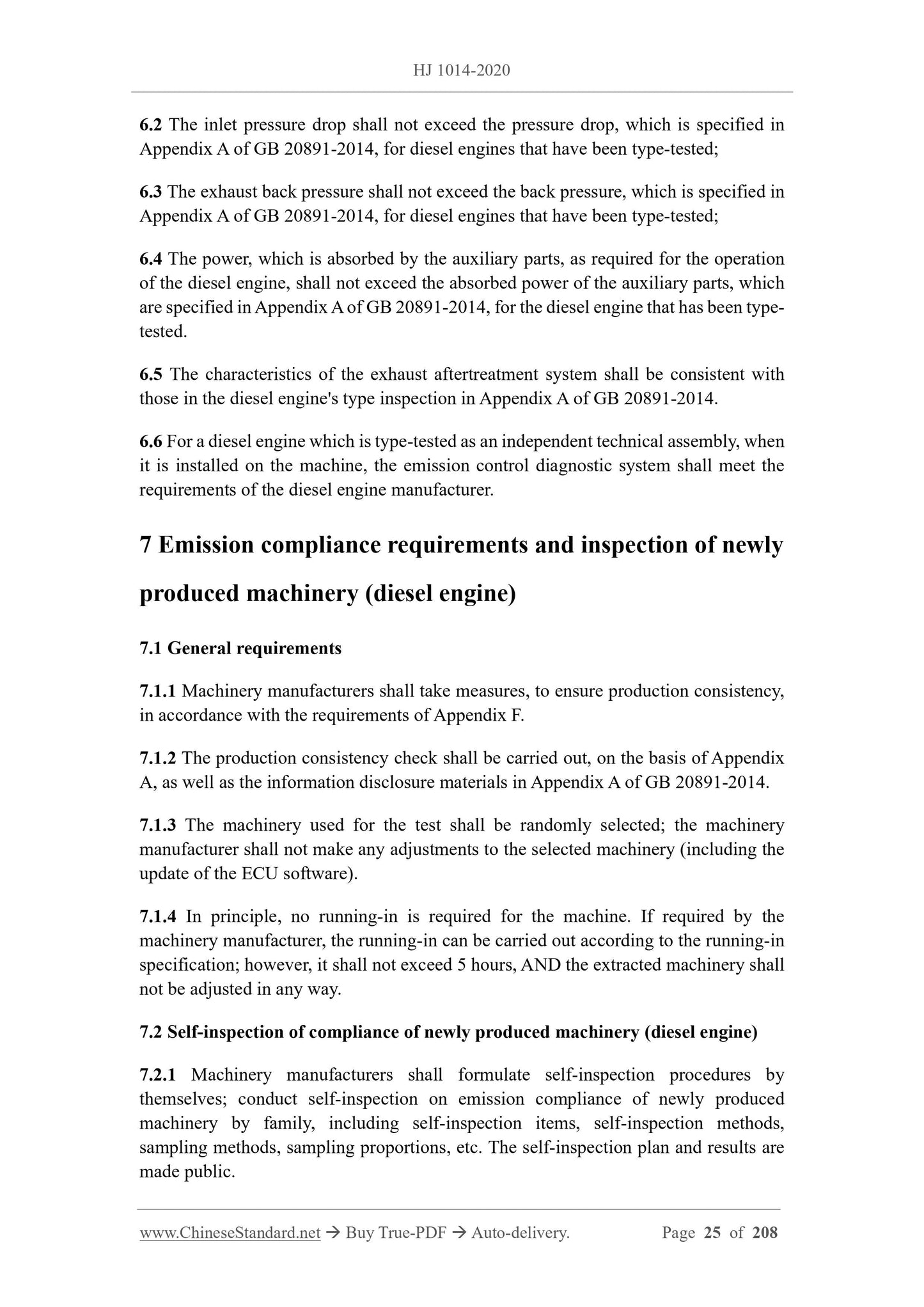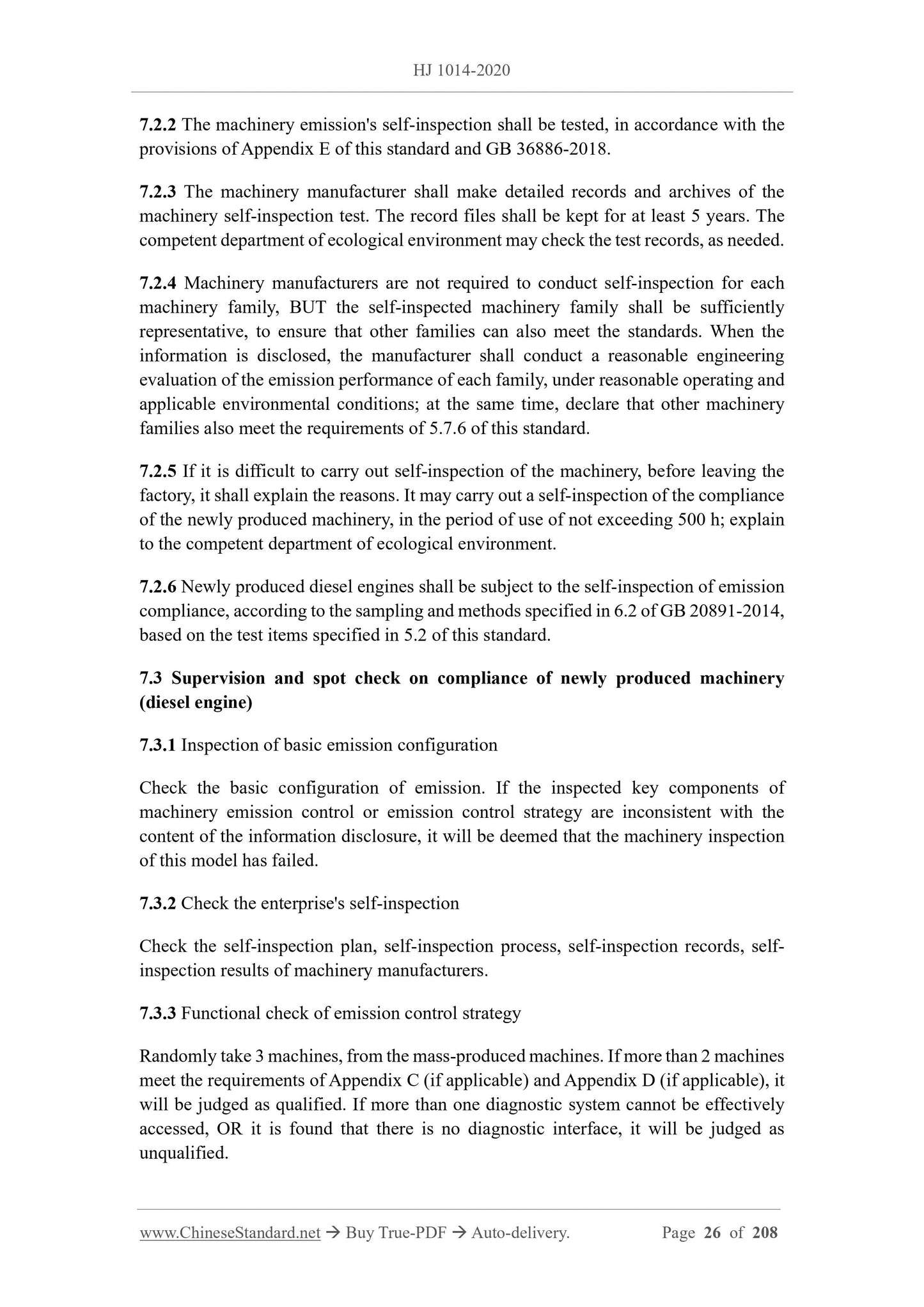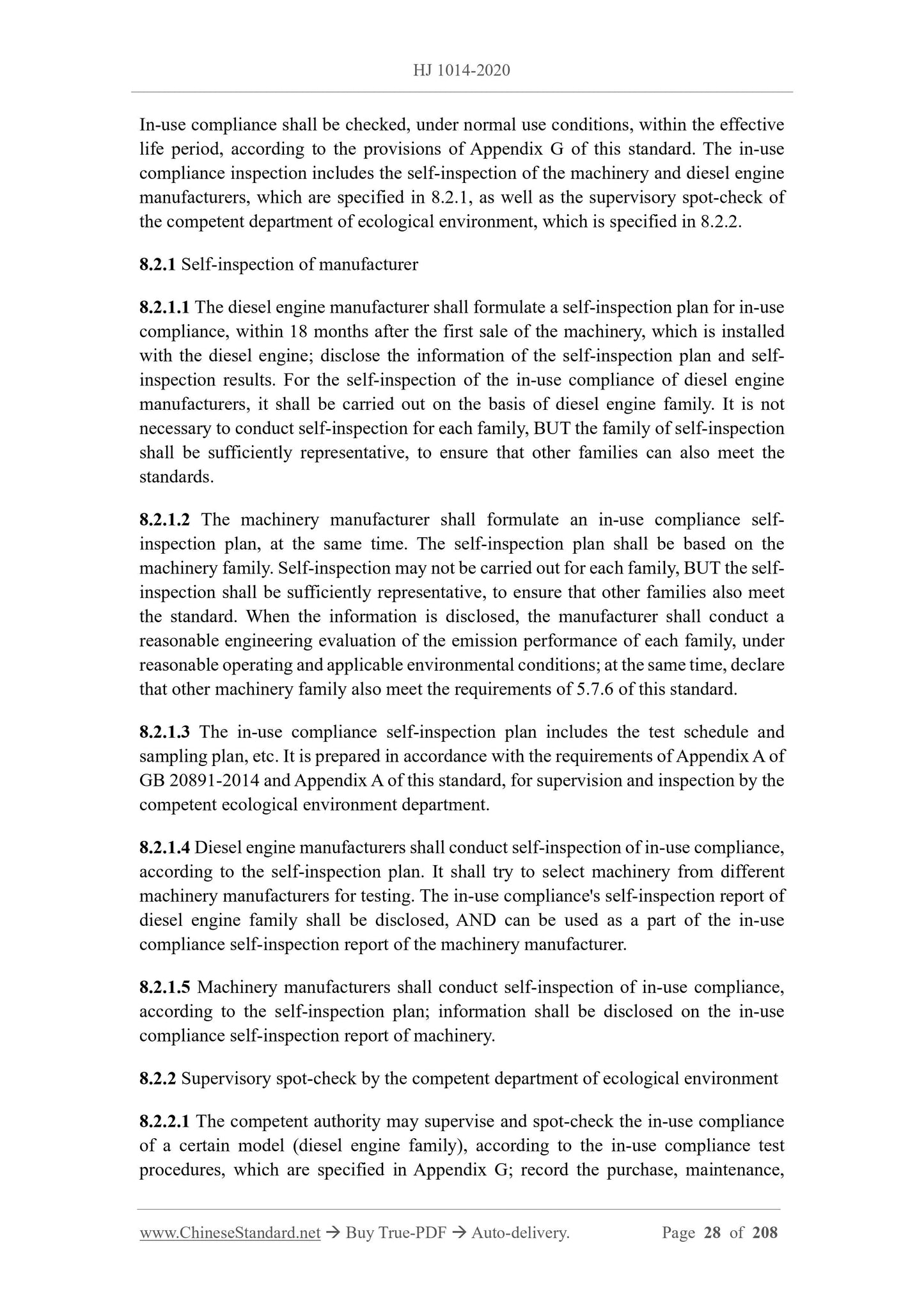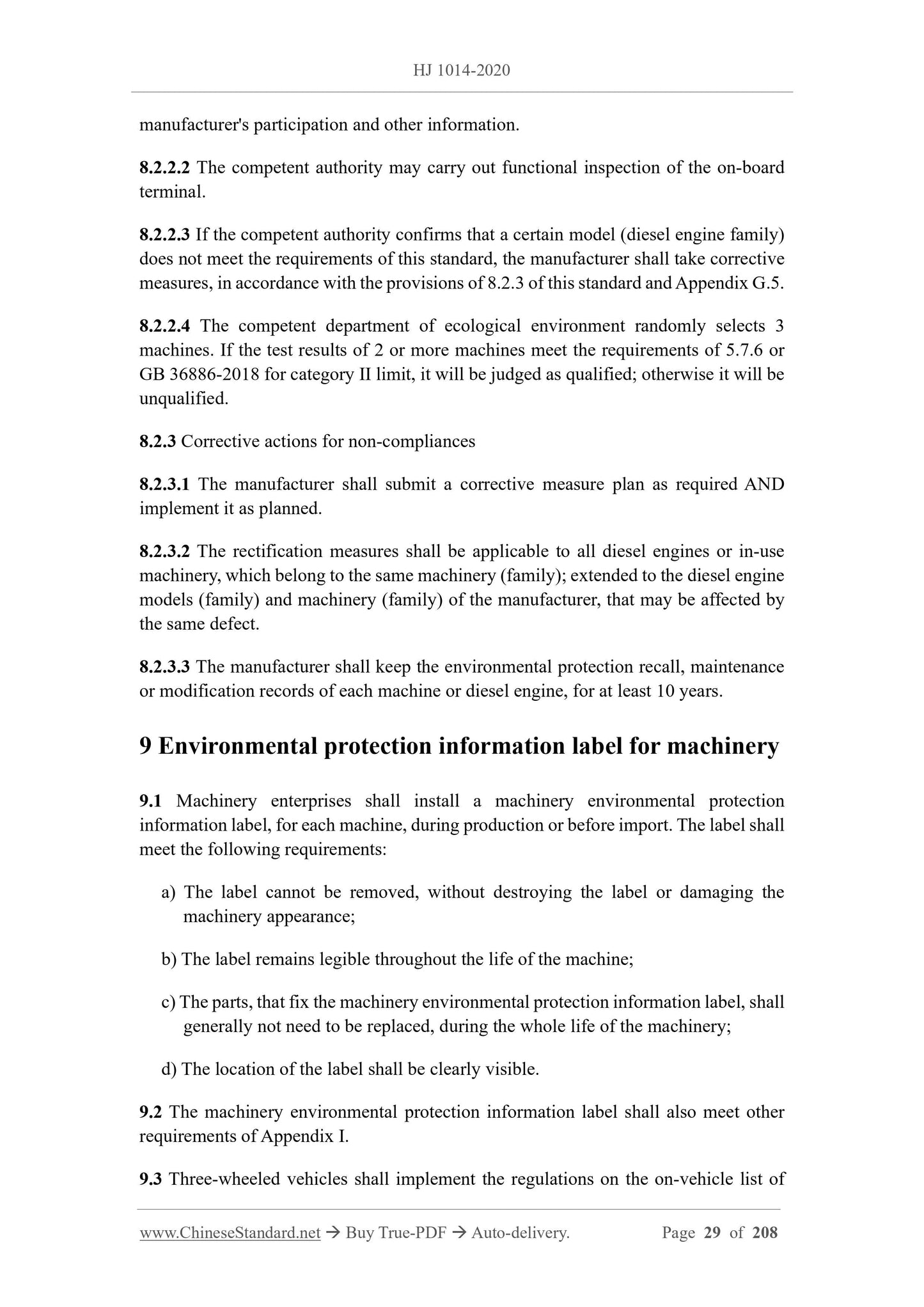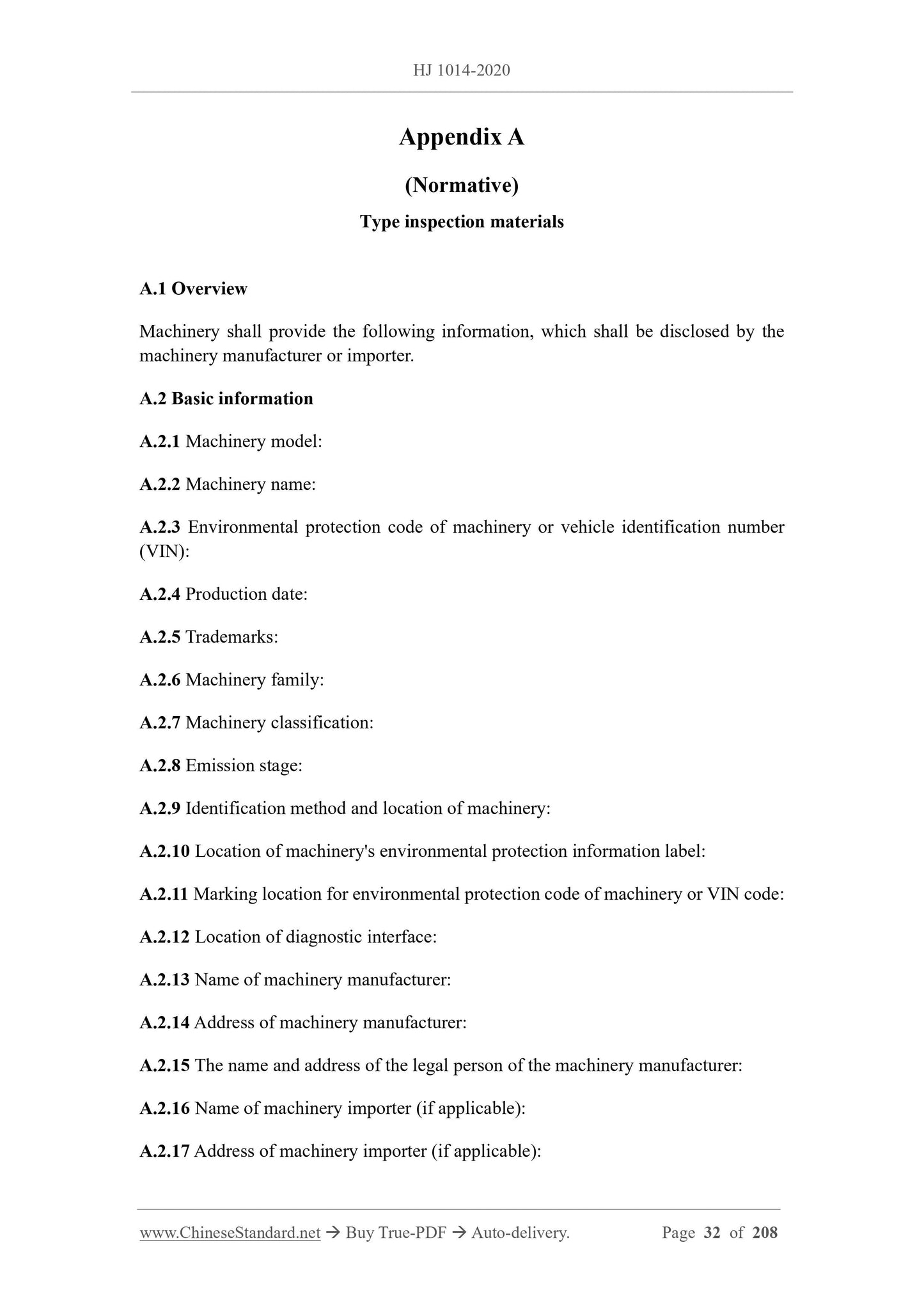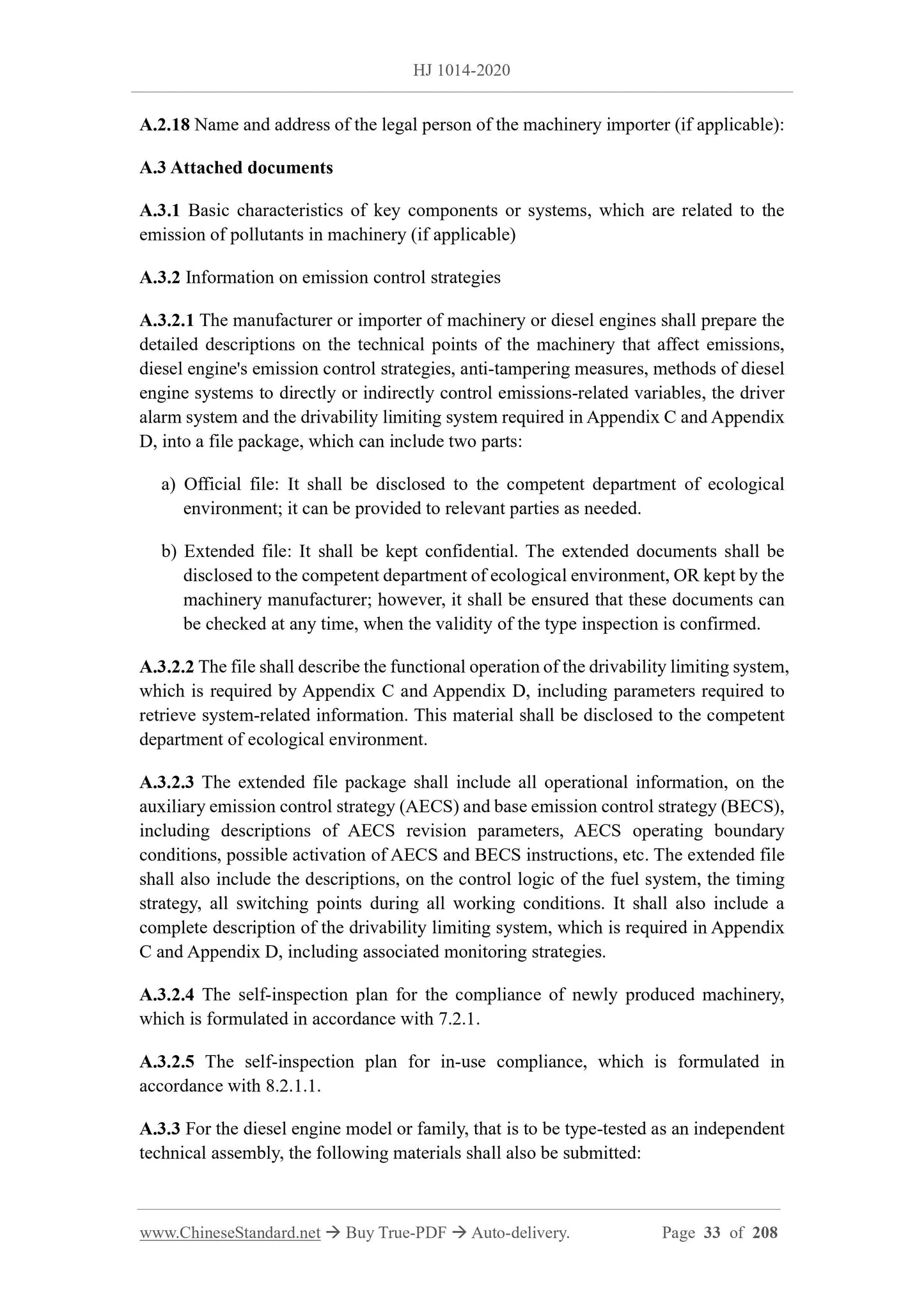1
/
of
12
www.ChineseStandard.us -- Field Test Asia Pte. Ltd.
HJ 1014-2020 English PDF
HJ 1014-2020 English PDF
Regular price
$1,705.00
Regular price
Sale price
$1,705.00
Unit price
/
per
Shipping calculated at checkout.
Couldn't load pickup availability
HJ 1014-2020: Emissions control technical requirements of non-road diesel mobile machinery
Delivery: 9 seconds. Download (& Email) true-PDF + Invoice.
Get Quotation: Click HJ 1014-2020 (Self-service in 1-minute)
Historical versions (Master-website): HJ 1014-2020
Preview True-PDF (Reload/Scroll-down if blank)
HJ 1014-2020
ENVIRONMENTAL PROTECTION STANDARD
OF THE PEOPLE’S REPUBLIC OF CHINA
Emissions control technical requirements of non-road diesel
mobile machinery
ISSUED ON: DECEMBER 28, 2020
IMPLEMENTED ON: DECEMBER 28, 2020
Issued by: Ministry of Ecological Environment
Table of Contents
Foreword ... 3
1 Scope ... 5
2 Normative references ... 6
3 Terms and definitions... 7
4 Pollution control requirements ... 14
5 Technical requirements and tests ... 16
6 Installation on the machine ... 24
7 Emission compliance requirements and inspection of newly produced machinery
(diesel engine) ... 25
8 In-use compliance requirements and inspections ... 27
9 Environmental protection information label for machinery ... 29
10 Family ... 30
Appendix A (Normative) Type inspection materials ... 32
Appendix B (Normative) Bench test procedures ... 46
Appendix C (Normative) Requirements for correct operation of NOX control measures
... 112
Appendix D (Normative) Requirements for correct operation of particulate control
measures ... 140
Appendix E (Normative) On-board testing procedures and requirements ... 150
Appendix F (Normative) Requirements for production consistency assurance and
inspection ... 168
Appendix G (Normative) Technical requirements for in-use compliance ... 171
Appendix H (Normative) Technical requirements for on-board terminals ... 178
Appendix I (Normative) Machinery's environmental information label ... 190
Appendix J (Normative) Technical requirements for confirmatory inspection ... 193
Appendix K (Normative) Machinery's environmental protection code ... 202
Emissions control technical requirements of non-road diesel
mobile machinery
1 Scope
This standard specifies the technical requirements for pollutant emission control of the
stage IV non-road diesel mobile machinery (hereinafter referred to as the machinery),
the diesel engine it is equipped with, as well as the second diesel engine installed in the
vehicle for carrying people (cargo) on the road.
This standard applies to the type inspection, production consistency inspection,
emission compliance inspection, in-use compliance inspection and durability
requirements, for the following (including but not limited to) machinery and diesel
engines installed at non-constant speed, such as:
- Construction machinery (including excavation machinery, shoveling machinery,
hoisting machinery, forklift trucks, compaction machinery, road construction and
maintenance machinery, concrete machinery, excavation machinery, piling
machinery, aerial work machinery, rock drilling machinery, etc.);
- Agricultural machinery (including tractors, combine harvesters, etc.);
- Forestry machinery;
- Airport ground handling equipment;
- Material handling machinery;
- Snow plow equipment;
- Industrial drilling equipment.
This standard applies to the type inspection, production consistency inspection,
emission compliance inspection, in-use compliance inspection, durability requirements,
for the following (including but not limited to) machinery and diesel engines installed
at constant speed, such as:
- Air compressor;
- Generator sets;
- Fishing machinery (aerators, pond excavators, etc.);
requirements of Table D.1 of GB 17691-2018, shall be used. The urea aqueous solution
(if applicable), that meets the requirements of GB 29518-2013, shall be used.
4.1.1.5 Diesel engine's labels shall be clear and easy to view; it may also be in the form
of a two-dimensional code.
4.1.1.6 When the diesel engine is on the bench, AND the measured maximum net power
and the rated net power are not in the same power range, meanwhile the requirements
of power deviation in B.2 are not met, it shall implement the emission limits and
technical requirements of the more stringent power range.
4.1.2 Type inspection of family (source machine)
4.1.2.1 During the diesel engine's type inspection, a source engine, that can represent
the diesel engine type or family, is to be selected. If the selected model cannot fully
represent the model or family, which is described in Appendix A of GB 20891-2014, an
additional representative diesel engine shall be selected for the test.
4.1.2.2 The source machine (machinery) shall have the worst emission level in this
family. The type inspection of the source machine (machinery) can be extended to all
members of the family; other members of the family need not to be subject to type
inspection.
4.1.2.3 The inspection agency shall seal up the ECU of the diesel engine during the type
inspection, for future reference. After the diesel engine or machinery has been shut
down for 5 years, it may not be retained.
4.1.2.4 The competent department of ecological environment may conduct
confirmation inspection, according to Appendix J.
4.2 Change of product type
For any modification of diesel engine models or machinery, that has been type-tested,
it shall not have adverse effects on pollutant emissions, AND still meet the requirements
of this standard. If the changed items are public information, machinery
manufacturers/importers shall disclose the information on the change of the product. If
the changed items may affect the emission performance, the corresponding type
inspection shall be carried out, AND the information of the product changes and type
inspection results shall be disclosed.
4.3 Information disclosure
4.3.1 For the machinery within the scope of application of this standard, the machinery
manufacturing/importing enterprises shall make information disclosure, in accordance
with the requirements of Appendix A of GB 20891-2014, as well as Appendix A of this
standard. Relevant content, which involves the secrets of diesel engine manufacturers,
may be disclosed by diesel engine enterprises, after technical processing.
4.3.2 Every machine must have an environmental protection information label fixed;
the environmental protection information label shall meet the requirements of Appendix
I.
4.3.3 Each machine must have a unique machinery environmental protection code; the
machinery environmental protection code shall meet the requirements of Appendix K.
4.4 Environmental production consistency and in-use compliance
4.4.1 Machinery and diesel engine manufacturers shall ensure the environmental
protection production consistency of mass-produced machinery and diesel engines;
provide relevant production consistency assurance materials, in accordance with the
requirements of Appendix F. Manufacturers shall, in accordance with the provisions of
this standard, ensure that the emissions of newly-produced machinery and diesel
engines meet the standards; prepare relevant materials for self-examination of
emissions from newly produced machinery and diesel engines, in accordance with the
requirements of Chapter 7. The competent authority of ecological environment may
carry out spot check, on the compliance of the newly produced machinery and diesel
engines.
4.4.2 Machinery and diesel engine manufacturers shall ensure the in-use compliance of
production machinery and diesel engines; prepare a relevant in-use compliance self-
inspection plan, according to the requirements of Appendix G. Manufacturers of
machinery and diesel engines shall ensure that the emissions of machinery in actual use
meet the standards, in accordance with the provisions of this standard; prepare a self-
inspection report on in-use compliance, according to the requirements of Chapter 8. The
competent authority of ecological environment may carry out spot check, on the in-use
compliance, according to the requirements of Chapter 8.
4.4.3 Machinery and three-wheeled vehicles, which are equipped with diesel engines
with rated net power of 37 kW and above, shall be inspected for compliance of newly
produced machinery and in-use compliance, in accordance with the requirements of
5.7.6 and GB 36886-2018. For machinery and three-wheeled vehicles, which are
equipped with diesel engines with a rated net power of less than 37 kW, they shall be
inspected for compliance of newly produced machinery and in-use compliance, in
accordance with the requirements of GB 36886-2018. For machinery with multiple
operating modes, inspection of compliance of newly produced machinery and in-use
compliance inspection shall be carried out, in various modes.
5 Technical requirements and tests
5.1 General requirements
5.1.1 Requirements for base emission control strategies
fuel consumption of the diesel engine, at the same time; record the measurement results.
5.3.3 When conducting the test, in accordance with the test procedures in Appendix B
of GB 20891-2014 and Appendix B of this standard, if any reactant is used, the
manufacturer shall ensure that the average NH3 emission of the diesel engine, in the
NRTC and NRSC cycles, does not exceed the limit requirements in Table 2 of the
Amendment sheet of GB 20891- 2014.
5.4 Non-standard cycle emission requirements
5.4.1 The requirements for non-standard cycle emissions apply to all diesel engines,
which have electronically controlled fuel systems, for machinery use.
5.4.2 The non-standard cyclic emission test requirements shall be carried out, after the
non-road steady cycle test conditions are completed, in accordance with the non-
standard cyclic emission requirements, which are specified in Appendix B.
5.4.3 At least 3 random load and rotational speed points shall be selected for testing, in
the emission area of non-standard cycle; the running sequence of the above test points
shall also be randomly determined. The test shall be carried out, according to the
requirements of the non-road steady cycle, BUT the specific emission of various
pollutants (excluding PN) shall be calculated separately, for each test point. The specific
emission of each test point shall not exceed twice the limit in Table 2 of the Amendment
sheet of GB 20891-2014.
5.5 Durability requirements
5.5.1 Durability requirements shall, in addition to meeting the requirements of
Appendix BD of GB 20891-2014, also meet the requirements of 5.5.2 ~ 5.5.4.
5.5.2 In the process of determining the deterioration factor or the deterioration
correction value, the rated net power and maximum net torque, at each test node, shall
meet the provisions of Appendix B.2.
5.5.3 One of the two test cycles, in B.3.8.1 and B.3.8.2 (only hot start cycle) of GB
20891-2014, can be used to determine the degradation coefficient or degradation
correction value, at each time node. Another test cycle required emissions testing, each
at the beginning and end of the durability test. The determined deterioration factor or
deterioration correction value is applicable to two cycles; the pollutant discharge, at
each node of the durability test, shall not exceed the limit specified in Table 2 of GB
20891-2014. A constant speed diesel engine requires only a non-road steady cycle.
5.5.4 Diesel engine manufacturers can choose the deterioration factor, which is
specified in Table 2, as the alternative durability deterioration factor. The specific
emission of each pollutant is multiplied by the deterioration factor, which is determined
in Table 2; the result shall not exceed the limit specified in Table 2 of GB 20891-2014.
For models that have passed the type inspection, using the deterioration factor specified
6.2 The inlet pressure drop shall not exceed the pressure drop, which is specified in
Appendix A of GB 20891-2014, for diesel engines that have been type-tested;
6.3 The exhaust back pressure shall not exceed the back pressure, which is specified in
Appendix A of GB 20891-2014, for diesel engines that have been type-tested;
6.4 The power, which is absorbed by the auxiliary parts, as required for the operation
of the diesel engine, shall not exceed the absorbed power of the auxiliary parts, which
are specified in Appendix A of GB 20891-2014, for the diesel engine that has been type-
tested.
6.5 The characteristics of the exhaust aftertreatment system shall be consistent with
those in the diesel engine's type inspection in Appendix A of GB 20891-2014.
6.6 For a diesel engine which is type-tested as an independent technical assembly, when
it is installed on the machine, the emission control diagnostic system shall meet the
requirements of the diesel engine manufacturer.
7 Emission compliance requirements and inspection of newly
produced machinery (diesel engine)
7.1 General requirements
7.1.1 Machinery manufacturers shall take measures, to ensure production consistency,
in accordance with the requirements of Appendix F.
7.1.2 The production consistency check shall be carried out, on the basis of Appendix
A, as well as the information disclosure materials in Appendix A of GB 20891-2014.
7.1.3 The machinery used for the test shall be randomly selected; the machinery
manufacturer shall not make any adjustments to the selected machinery (including the
update of the ECU software).
7.1.4 In principle, no running-in is required for the machine. If required by the
machinery manufacturer, the running-in can be carried out according to the running-in
specification; however, it shall not exceed 5 hours, AND the extracted machinery shall
not be adjusted in any way.
7.2 Self-inspection of compliance of newly produced machinery (diesel engine)
7.2.1 Machinery manufacturers shall formulate self-inspection procedures by
themselves; conduct self-inspection on emission compliance of newly produced
machinery by family, including self-inspection items, self-inspection methods,
sampling methods, sampling proportions, etc. The self-inspection plan and results are
made public.
7.2.2 The machinery emission's self-inspection shall be tested, in accordance with the
provisions of Appendix E of this standard and GB 36886-2018.
7.2.3 The machinery manufacturer shall make detailed records and archives of the
machinery self-inspection test. The record files shall be kept for at least 5 years. The
competent department of ecological environment may check the test records, as ...
Delivery: 9 seconds. Download (& Email) true-PDF + Invoice.
Get Quotation: Click HJ 1014-2020 (Self-service in 1-minute)
Historical versions (Master-website): HJ 1014-2020
Preview True-PDF (Reload/Scroll-down if blank)
HJ 1014-2020
ENVIRONMENTAL PROTECTION STANDARD
OF THE PEOPLE’S REPUBLIC OF CHINA
Emissions control technical requirements of non-road diesel
mobile machinery
ISSUED ON: DECEMBER 28, 2020
IMPLEMENTED ON: DECEMBER 28, 2020
Issued by: Ministry of Ecological Environment
Table of Contents
Foreword ... 3
1 Scope ... 5
2 Normative references ... 6
3 Terms and definitions... 7
4 Pollution control requirements ... 14
5 Technical requirements and tests ... 16
6 Installation on the machine ... 24
7 Emission compliance requirements and inspection of newly produced machinery
(diesel engine) ... 25
8 In-use compliance requirements and inspections ... 27
9 Environmental protection information label for machinery ... 29
10 Family ... 30
Appendix A (Normative) Type inspection materials ... 32
Appendix B (Normative) Bench test procedures ... 46
Appendix C (Normative) Requirements for correct operation of NOX control measures
... 112
Appendix D (Normative) Requirements for correct operation of particulate control
measures ... 140
Appendix E (Normative) On-board testing procedures and requirements ... 150
Appendix F (Normative) Requirements for production consistency assurance and
inspection ... 168
Appendix G (Normative) Technical requirements for in-use compliance ... 171
Appendix H (Normative) Technical requirements for on-board terminals ... 178
Appendix I (Normative) Machinery's environmental information label ... 190
Appendix J (Normative) Technical requirements for confirmatory inspection ... 193
Appendix K (Normative) Machinery's environmental protection code ... 202
Emissions control technical requirements of non-road diesel
mobile machinery
1 Scope
This standard specifies the technical requirements for pollutant emission control of the
stage IV non-road diesel mobile machinery (hereinafter referred to as the machinery),
the diesel engine it is equipped with, as well as the second diesel engine installed in the
vehicle for carrying people (cargo) on the road.
This standard applies to the type inspection, production consistency inspection,
emission compliance inspection, in-use compliance inspection and durability
requirements, for the following (including but not limited to) machinery and diesel
engines installed at non-constant speed, such as:
- Construction machinery (including excavation machinery, shoveling machinery,
hoisting machinery, forklift trucks, compaction machinery, road construction and
maintenance machinery, concrete machinery, excavation machinery, piling
machinery, aerial work machinery, rock drilling machinery, etc.);
- Agricultural machinery (including tractors, combine harvesters, etc.);
- Forestry machinery;
- Airport ground handling equipment;
- Material handling machinery;
- Snow plow equipment;
- Industrial drilling equipment.
This standard applies to the type inspection, production consistency inspection,
emission compliance inspection, in-use compliance inspection, durability requirements,
for the following (including but not limited to) machinery and diesel engines installed
at constant speed, such as:
- Air compressor;
- Generator sets;
- Fishing machinery (aerators, pond excavators, etc.);
requirements of Table D.1 of GB 17691-2018, shall be used. The urea aqueous solution
(if applicable), that meets the requirements of GB 29518-2013, shall be used.
4.1.1.5 Diesel engine's labels shall be clear and easy to view; it may also be in the form
of a two-dimensional code.
4.1.1.6 When the diesel engine is on the bench, AND the measured maximum net power
and the rated net power are not in the same power range, meanwhile the requirements
of power deviation in B.2 are not met, it shall implement the emission limits and
technical requirements of the more stringent power range.
4.1.2 Type inspection of family (source machine)
4.1.2.1 During the diesel engine's type inspection, a source engine, that can represent
the diesel engine type or family, is to be selected. If the selected model cannot fully
represent the model or family, which is described in Appendix A of GB 20891-2014, an
additional representative diesel engine shall be selected for the test.
4.1.2.2 The source machine (machinery) shall have the worst emission level in this
family. The type inspection of the source machine (machinery) can be extended to all
members of the family; other members of the family need not to be subject to type
inspection.
4.1.2.3 The inspection agency shall seal up the ECU of the diesel engine during the type
inspection, for future reference. After the diesel engine or machinery has been shut
down for 5 years, it may not be retained.
4.1.2.4 The competent department of ecological environment may conduct
confirmation inspection, according to Appendix J.
4.2 Change of product type
For any modification of diesel engine models or machinery, that has been type-tested,
it shall not have adverse effects on pollutant emissions, AND still meet the requirements
of this standard. If the changed items are public information, machinery
manufacturers/importers shall disclose the information on the change of the product. If
the changed items may affect the emission performance, the corresponding type
inspection shall be carried out, AND the information of the product changes and type
inspection results shall be disclosed.
4.3 Information disclosure
4.3.1 For the machinery within the scope of application of this standard, the machinery
manufacturing/importing enterprises shall make information disclosure, in accordance
with the requirements of Appendix A of GB 20891-2014, as well as Appendix A of this
standard. Relevant content, which involves the secrets of diesel engine manufacturers,
may be disclosed by diesel engine enterprises, after technical processing.
4.3.2 Every machine must have an environmental protection information label fixed;
the environmental protection information label shall meet the requirements of Appendix
I.
4.3.3 Each machine must have a unique machinery environmental protection code; the
machinery environmental protection code shall meet the requirements of Appendix K.
4.4 Environmental production consistency and in-use compliance
4.4.1 Machinery and diesel engine manufacturers shall ensure the environmental
protection production consistency of mass-produced machinery and diesel engines;
provide relevant production consistency assurance materials, in accordance with the
requirements of Appendix F. Manufacturers shall, in accordance with the provisions of
this standard, ensure that the emissions of newly-produced machinery and diesel
engines meet the standards; prepare relevant materials for self-examination of
emissions from newly produced machinery and diesel engines, in accordance with the
requirements of Chapter 7. The competent authority of ecological environment may
carry out spot check, on the compliance of the newly produced machinery and diesel
engines.
4.4.2 Machinery and diesel engine manufacturers shall ensure the in-use compliance of
production machinery and diesel engines; prepare a relevant in-use compliance self-
inspection plan, according to the requirements of Appendix G. Manufacturers of
machinery and diesel engines shall ensure that the emissions of machinery in actual use
meet the standards, in accordance with the provisions of this standard; prepare a self-
inspection report on in-use compliance, according to the requirements of Chapter 8. The
competent authority of ecological environment may carry out spot check, on the in-use
compliance, according to the requirements of Chapter 8.
4.4.3 Machinery and three-wheeled vehicles, which are equipped with diesel engines
with rated net power of 37 kW and above, shall be inspected for compliance of newly
produced machinery and in-use compliance, in accordance with the requirements of
5.7.6 and GB 36886-2018. For machinery and three-wheeled vehicles, which are
equipped with diesel engines with a rated net power of less than 37 kW, they shall be
inspected for compliance of newly produced machinery and in-use compliance, in
accordance with the requirements of GB 36886-2018. For machinery with multiple
operating modes, inspection of compliance of newly produced machinery and in-use
compliance inspection shall be carried out, in various modes.
5 Technical requirements and tests
5.1 General requirements
5.1.1 Requirements for base emission control strategies
fuel consumption of the diesel engine, at the same time; record the measurement results.
5.3.3 When conducting the test, in accordance with the test procedures in Appendix B
of GB 20891-2014 and Appendix B of this standard, if any reactant is used, the
manufacturer shall ensure that the average NH3 emission of the diesel engine, in the
NRTC and NRSC cycles, does not exceed the limit requirements in Table 2 of the
Amendment sheet of GB 20891- 2014.
5.4 Non-standard cycle emission requirements
5.4.1 The requirements for non-standard cycle emissions apply to all diesel engines,
which have electronically controlled fuel systems, for machinery use.
5.4.2 The non-standard cyclic emission test requirements shall be carried out, after the
non-road steady cycle test conditions are completed, in accordance with the non-
standard cyclic emission requirements, which are specified in Appendix B.
5.4.3 At least 3 random load and rotational speed points shall be selected for testing, in
the emission area of non-standard cycle; the running sequence of the above test points
shall also be randomly determined. The test shall be carried out, according to the
requirements of the non-road steady cycle, BUT the specific emission of various
pollutants (excluding PN) shall be calculated separately, for each test point. The specific
emission of each test point shall not exceed twice the limit in Table 2 of the Amendment
sheet of GB 20891-2014.
5.5 Durability requirements
5.5.1 Durability requirements shall, in addition to meeting the requirements of
Appendix BD of GB 20891-2014, also meet the requirements of 5.5.2 ~ 5.5.4.
5.5.2 In the process of determining the deterioration factor or the deterioration
correction value, the rated net power and maximum net torque, at each test node, shall
meet the provisions of Appendix B.2.
5.5.3 One of the two test cycles, in B.3.8.1 and B.3.8.2 (only hot start cycle) of GB
20891-2014, can be used to determine the degradation coefficient or degradation
correction value, at each time node. Another test cycle required emissions testing, each
at the beginning and end of the durability test. The determined deterioration factor or
deterioration correction value is applicable to two cycles; the pollutant discharge, at
each node of the durability test, shall not exceed the limit specified in Table 2 of GB
20891-2014. A constant speed diesel engine requires only a non-road steady cycle.
5.5.4 Diesel engine manufacturers can choose the deterioration factor, which is
specified in Table 2, as the alternative durability deterioration factor. The specific
emission of each pollutant is multiplied by the deterioration factor, which is determined
in Table 2; the result shall not exceed the limit specified in Table 2 of GB 20891-2014.
For models that have passed the type inspection, using the deterioration factor specified
6.2 The inlet pressure drop shall not exceed the pressure drop, which is specified in
Appendix A of GB 20891-2014, for diesel engines that have been type-tested;
6.3 The exhaust back pressure shall not exceed the back pressure, which is specified in
Appendix A of GB 20891-2014, for diesel engines that have been type-tested;
6.4 The power, which is absorbed by the auxiliary parts, as required for the operation
of the diesel engine, shall not exceed the absorbed power of the auxiliary parts, which
are specified in Appendix A of GB 20891-2014, for the diesel engine that has been type-
tested.
6.5 The characteristics of the exhaust aftertreatment system shall be consistent with
those in the diesel engine's type inspection in Appendix A of GB 20891-2014.
6.6 For a diesel engine which is type-tested as an independent technical assembly, when
it is installed on the machine, the emission control diagnostic system shall meet the
requirements of the diesel engine manufacturer.
7 Emission compliance requirements and inspection of newly
produced machinery (diesel engine)
7.1 General requirements
7.1.1 Machinery manufacturers shall take measures, to ensure production consistency,
in accordance with the requirements of Appendix F.
7.1.2 The production consistency check shall be carried out, on the basis of Appendix
A, as well as the information disclosure materials in Appendix A of GB 20891-2014.
7.1.3 The machinery used for the test shall be randomly selected; the machinery
manufacturer shall not make any adjustments to the selected machinery (including the
update of the ECU software).
7.1.4 In principle, no running-in is required for the machine. If required by the
machinery manufacturer, the running-in can be carried out according to the running-in
specification; however, it shall not exceed 5 hours, AND the extracted machinery shall
not be adjusted in any way.
7.2 Self-inspection of compliance of newly produced machinery (diesel engine)
7.2.1 Machinery manufacturers shall formulate self-inspection procedures by
themselves; conduct self-inspection on emission compliance of newly produced
machinery by family, including self-inspection items, self-inspection methods,
sampling methods, sampling proportions, etc. The self-inspection plan and results are
made public.
7.2.2 The machinery emission's self-inspection shall be tested, in accordance with the
provisions of Appendix E of this standard and GB 36886-2018.
7.2.3 The machinery manufacturer shall make detailed records and archives of the
machinery self-inspection test. The record files shall be kept for at least 5 years. The
competent department of ecological environment may check the test records, as ...
Share
